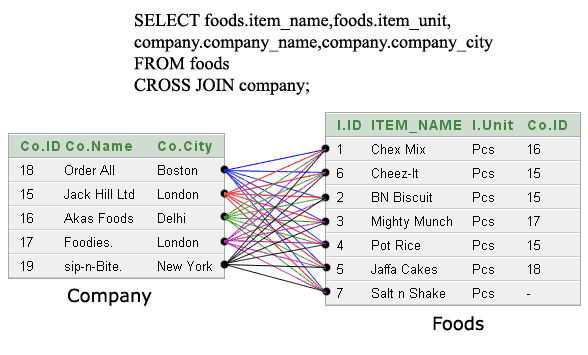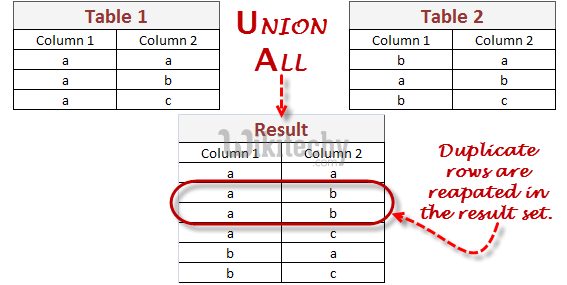An Oracle JOIN is performed whenever two or more tables are joined in a SQL statement. The JOIN operations are: INNER JOIN operation. Specifies a join between two tables with an explicit join clause.

To execute a join of three or more tables, Oracle first joins two of the tables based on the join conditions comparing their columns and then joins the result to another table based on join conditions containing columns of the joined tables and the new table. Oracle continues this process until all tables are joined into the result. Die verschiedenen Datenbankmanagementsysteme weichen teilweise vom SQL-Standard ab oder haben andere Varianten für die Formulierung des äußeren Verbunds.
Die folgenden Links verweisen auf die Dokumentation zum Join für einige der gängigen Produkte: IBM Db2. IBM Dbunterstützt die Variante NATURAL JOIN nicht. This means that Oracle will still return records from the other side of the join even when there is no match. Ein Oracle JOIN wird ausgeführt, wenn zwei oder mehr Tabellen in einer SQL-Anweisung verknüpft werden.
Für Verknüpfungen, die durch Klammern gegliedert werden, nehmen wir ein anderes Beispiel, nämlich „Mitarbeiter RIGHT JOIN Dienstwagen“, denn die Fahrzeugtypen sind eine Ergänzung zu den Dienstwagen, nicht zu den Mitarbeitern (auch wenn den Abteilungsleitern ein Mercedes zugestanden wir aber das ist ein anderes Thema und hat nichts mit SQL zu tun). So sind die Daten zu einer Bestellung (Artikel, Datum, Menge, Vertreter) in der Beispiel-Datenbank nicht in einer Tabelle. OUTER JOIN wird im nächsten Kapitel behandelt.
NEW It depends if the inline view is considered updateable by Oracle ( To be updatable for the second statement depends on some rules listed here). Learn how to use left and right joins using the plus sign in an Oracle database. Oracle SQL Tutorial: Joins Verbinden von Daten mehrerer Tabellen Sollen Informationen mehrerer Tabellen in einer Abfrage zusammengefasst werden, so benötigt man einen Join.
SQL ist nicht ganz einfach zu verstehen, speziell wenn es darum geht mehrere Tabellen mit joins zusammenzufassen bzw zu verknüpfen. Im Folgenden wird dem SQL Einsteiger sehr einfach mit Venn Diagrammen sowie einfachen SQL queries erklärt wie die verschiedenen SQL joins funktionieren. Dazu werden zwei Beispieltabellen mit Daten benutzt und.
The self join can be viewed as a join of two copies of the same table. The table is not actually copie but SQL performs the command as though it were. SQL HOME SQL Intro SQL Syntax SQL Select SQL Select Distinct SQL Where SQL An Or, Not SQL Order By SQL Insert Into SQL Null Values SQL Update SQL Delete SQL Select Top SQL Min and Max SQL Count, Avg, Sum SQL Like SQL Wildcards SQL In SQL Between SQL Aliases SQL Joins SQL Inner Join SQL Left Join SQL Right Join SQL Full Join SQL Self Join SQL. FROM tablea, tableb WHERE a. Oracle SQL Developer is a free, development environment that simplifies the management of Oracle Database in both traditional and Cloud deployments. Vern wir das ganze mal an einem konkreten Beispiel.
Im Teil SQL für Fortgeschrittene haben wir ein paar neue Testtabellen angelegt, mit denen wir jetzt arbeiten werden. Als erstes machen wir ein einfachen SELECT, indem wir alle. It is the most common type of SQL join. SQL INNER JOINS return all rows from multiple tables where the join condition is met.
The INNER join is such a join when equijoins and nonequijoins are performe rows from the source and target tables are matched using a join condition formulated with equality and inequality operators, respectively. This tutorial explains INNER JOIN and uses in Oracle. Die Syntax für die Verknüpfung als äußerer Verbund in SQL ist datenbankabhängig. The advantage of the latter is that repeated references to the subquery may be more efficient as the data is easily retrieved.
The WITH clause may be processed as an inline view or resolved as a temporary table. In diesem Beitrag gehe ich der Frage nach wie bekommt man mit SQL die Datensätze einer Tabelle, die nicht mit einem Datensatz einer anderen Tabelle Verknüpft sind. Oracle has the ability to update a table used in a join , however there is a restriction that Oracle must know in advance that the table acting as the source must be unique for each row in the target. I hope I worded that correctly).
You have the same restriction logically with a subquery because if it returns more than one row the update. To execute a join , Oracle combines pairs of rows, each containing one row from each table, for which the join condition evaluates to TRUE. The columns in the join conditions need not also appear in the select list. Update with Join Below are two similar and simple to understand examples of Update with Join.

An equijoin combines rows that have.
Keine Kommentare:
Kommentar veröffentlichen
Hinweis: Nur ein Mitglied dieses Blogs kann Kommentare posten.